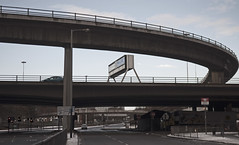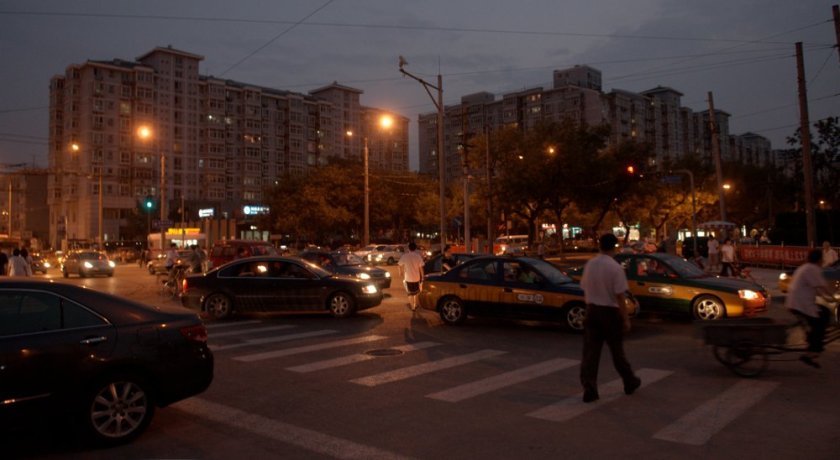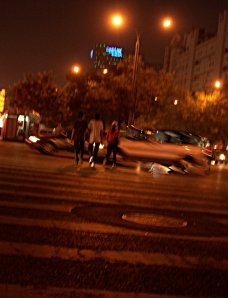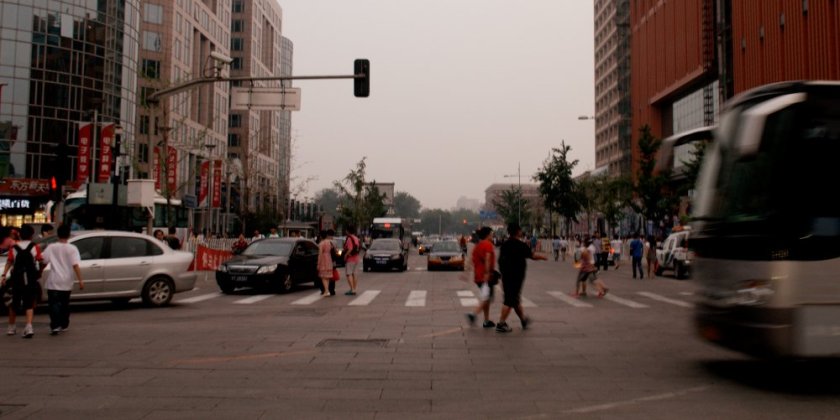This week, science writer Angela Saini introduced Radio 4 listeners to “shared space” in Thinking Streets.
The premise was that there is currently a “war” between the different users of streets,* that the way to create peace has puzzled policy makers for a long time, but that new research points to shared space as the solution.
The conflict on our streets is real. But I think that’s about all that is correct about the story. How to create peace is not a puzzle: policy makers know how to do it, and have known for decades. And new research doesn’t point to shared space as the answer. There’s really very little of what a scientist would recognise as research in shared space — not because streets are not something that lend themselves to the scientific method, but because, despite the importance of streets to our health, wealth and happiness, the budgets and expertise required for proper research are rarely turned to the topic.
This doesn’t mean that there isn’t a powerful group of people who have convinced themselves that shared space is the revolutionary solution to the problems with our streets. The programme was largely devoted to the now familiar routine of these shared space evangelists, but there are a number of important things missing from the evangelists’ routine — things that I think would have been interesting to hear about in the “street science” narrative.
The first thing that is missing is the full story of the wider differences between the streets of the UK and those of the evangelists’ preferred example, the Netherlands. The second is the full story of the history of risk compensation on the roads. And the third is the full story of how the UK came to be transforming streets into “shared space”.
The first story is one that readers of this blog will now be familiar with. The Dutch have a far more advanced system of roads and streets than we have in the UK. We just pour asphalt everywhere, preferably in a configuration that allows people to drive fast, sometimes put a footway on the side, and then let people drive cars and trucks anywhere and everywhere. The Dutch, meanwhile, take care to distinguish between roads, streets and lanes, build them differently, and have clear and widely understood differences in the expected use of and behaviour on them. And they build them following the principles of “sustainable safety”: ensuring that users share space only with other users who have roughly similar kinetic energy and direction.
That last point should have been made when introducing what the programme calls “home zones” (though British “home zones” have never fully replicated the Dutch woonerven). Woonerven apply the sustainable safety principle that you only mix users who have roughly similar energy — by banning heavy vehicles, and cutting the speed of the remaining motor vehicles to a crawl. “Shared space” may share some of the superficial characteristics of woonerven, but the crucial one for making people safe and comfortable is the equality of energy.
These wider differences between the UK and the Netherlands are important. They mean that Dutch drivers already understand streets differently to British drivers. And they mean that the Dutch have a vastly different proportion of journeys made by bicycle. The demands for, purpose, effects, and success of novel street designs are therefore going to be different in the Netherlands than equivalent changes in the UK.
The second story that was missing from the programme was about risk compensation. The evangelists told the usual story to explain how shared space is supposed to work: “an environment that overtly keeps us safe makes us behave less cautiously, whereas a shared space makes us more sensible.” Motorists, the story goes, will see the unfamiliar shared space street scene, with its jumble of different users and lack of signs to tell them what to do, and their automatic response will be to slow down and pay more attention. Pedestrians and cyclists, meanwhile, will respond to the increased sense of danger and discomfort by pricking up their ears and keeping their wits about them. Risk compensation, the story goes, means that in shared space everybody will become friendly, with drivers giving way and letting pedestrians cross.
This is little more than a just-so story. Even in the Netherlands, the evidence that it actually happens this way is weak and far from scientific. In Britain, though, it can be outright contradicted by ten minutes hanging around any shared space street. Taxi drivers still speed up Exhibition Road (if there isn’t a traffic jam already blocking the street). Traffic still completely dominates the seafront at Blackpool, and the blind and disabled now stay away from it. There’s not much friendliness from the white van men at Seven Dials. “Where once you would feel crazy walking on the carriageway…,” they say of Exhibition Road. Well, observations of the scheme so far suggests that pedestrians and motorists alike will view anybody on foot who casually “shares” the carriageway — walking outside of the clear pedestrian “safe zone” — to be crazy, and will shout and blast their horns at such people.
Saini observes that in the Netherlands cars “just stop” for pedestrians trying to cross the shared space. London cabbies and commercial drivers on a deadline don’t stop for red traffic lights, let alone mere pedestrians trying to get in their way. That Dutch drivers do is less a product of the shared space environment and more to do with the fact that the Dutch recognise a fundamental difference between “roads” and “streets” and how people are expected to behave on them.
Risk compensation theory is legitimate science, but in shared space the theory is applied to explain a phenomenon that, at least in the UK, just doesn’t exit: motorists becoming more cautious and friendly. In fact, the results of risk compensation can be seen all over British streets, and risk compensation on the roads has been a powerful force shaping our behaviour, built environment, and health and wealth for almost a century. But with the exact opposite effect of that claimed for shared space.
The Rt Hon JTC Moore-Brabazon recognised the existence of risk compensation when he said, in objection to the introduction of speed limits in 1934:
“It is true that 7000 people are killed in motor accidents, but it is not always going on like that. People are getting used to the new conditions… No doubt many of the old Members of the House will recollect the number of chickens we killed in the old days. We used to come back with the radiator stuffed with feathers. It was the same with dogs. Dogs get out of the way of motor cars nowadays and you never kill one. There is education even in the lower animals. These things will right themselves.”
When people feel unsafe and uncomfortable, they stop doing whatever it is that makes them feel that way, or stop going to the places where they feel unsafe. It is entirely true that, as the programme says, “an environment that overtly keeps us safe makes us behave less cautiously, whereas a shared space makes us more sensible.” The environment that overtly keeps us safe — and which has kept us more safe with every technological innovation and toughened standard — is the interior of the motor car. In the safety of the motor car people behave without caution. The result is that everybody else feels less safe and compensates by getting out of the way. We walk less and less, bundle kids into SUVs for the school run, and most people will now never consider using a bicycle. JTC Moore-Brabazon recognised this process of risk compensation in the 1930s.
The shared space/risk compensation hypothesis is not simply a just-so story. It’s a just-so story that ignores all of our previous experience of streets. When pedestrians and cyclists felt uncomfortable and threatened by the rise of motor traffic on their streets, they compensated by getting out of the way. They went somewhere else, or swapped the bicycle for a car of their own. So when the programme says that, statistically, Dutch shared space is at least as safe as the traditional streets that it replaces (it’s probably not (p10)), far from being proof that those streets are working because “everyone becomes aware of each-other”, it is in fact just another consequence of the most vulnerable road users staying away from those streets. The increased risk of collisions and injuries on these streets is compensated for by those people who are most likely to get injured — the pedestrians that schemes like Exhibition Road are supposed to attract — staying away.
The final story that is not properly explored is why Britain is building shared space streets and other “road loveliness”, as the programme puts it, such as the scramble crossing at Oxford Circus. The programme’s only comment on this was that we are now designing places for people instead of merely designing places for cars. In fact, designing successful places for people has been going on for a long time. To create them, you first get rid of cars. In his 1995 Reith Lecture, “The Sustainable City”, Richard Rogers described all the opportunities that came from removing motor vehicles from places, and listed some of the top priority places in London that needed the treatment. The terrace in front of the National Gallery on Trafalgar Square was one, and this was implemented in 2003, creating a largely pedestrianised zone between Trafalgar and Leicester Squares. One side of Parliament Square almost followed, but the plans were cancelled when Boris came to City Hall, and our politicians now seem determined to keep Parliament Square as an isolated and desolate traffic island forever. A riverside park in place of the Embankment road from Parliament Square to Blackfriars Bridge was the most radical of the suggestions, and the one that politicians wanted least to do with. And then there was Exhibition Road:
Albertopolis – the collection of major museums and universities in South Kensington, including the Albert Hall and the Victoria and Albert Museum – could be connected across the road into Hyde Park. Exhibition Road could become a pedestrianised millennium avenue, part of a network of tree-lined routes.
Exhibition Road has been transformed because the case for transformation was overwhelming. The need to make a more attractive environment and the opportunities and benefits of a place for people were obvious. But shared space is a miserable compromise. Shared space on Exhibition Road is not an alternative to the old four-lane highway layout, a layout that everybody already agreed could not be allowed to stay on such an important street. It is an alternative to the much needed and long called for removal of the motor vehicles, which will now continue to dominate the space, continue to separate Albert, perched in the park, from Albertopolis, and continue to choke South Kensington with pollution.
Far from being a case of people reclaiming the streets from cars, Exhibition Road and Oxford Circus are examples of places where traffic has succeeded in clinging on to its ownership and dominance of streets that so obviously needed to be properly reclaimed. None of the great economic and cultural opportunities that Richard Rogers described have been enabled by the changes. No modal shift, no health or environmental benefits will result from them. It was built — for £30 million — but they won’t come for fancy paving alone.
(I don’t think the programme makers can be blamed for failing to discuss these points — the fault lies with the shared space True Believers. Shared space is currently very trendy in a field that doesn’t have much experience with scientific skepticism. There are a lot of people who desperately want it to work and so have convinced themselves that it must work — as one person tweeted, if Jeremy Clarkson is a critic, it must be a good thing. Steve Melia is one of the few academics to have tried to introduce some of the much needed scientific skepticism — and I imagine the publication of his paper came too late for the programme.)
—
Shared space is the topic of next week’s Street Talk: Stuart Reid, Director of Sustainable Transport and Communities, MVA Consultancy, will talk about Creating successful shared space streets, followed by a chance to raise questions. As usual it’s upstairs at The Yorkshire Grey, 2 Theobalds Road, WC1X 8PN at 7pm (bar open 6pm) on Tuesday 10th January.
—
* illustrated by broadcasting sound bites that included the sort of massacre fantasies that would, with any other kind of weapon, result in arrest, but for some reason never does when the weapon is a motor vehicle.





















